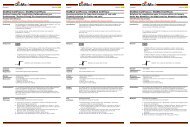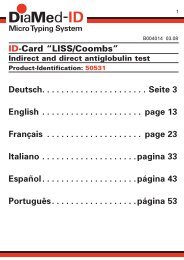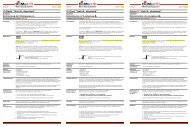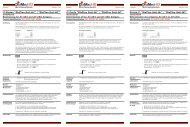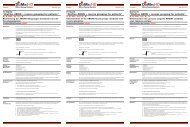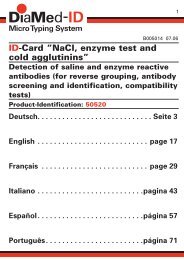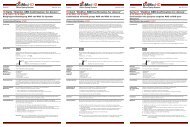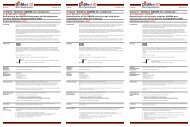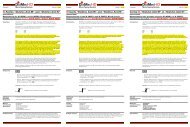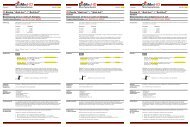DiaClon Anti-A, DiaClon Anti-B, DiaClon Anti-AB DiaClon Anti-A ...
DiaClon Anti-A, DiaClon Anti-B, DiaClon Anti-AB DiaClon Anti-A ...
DiaClon Anti-A, DiaClon Anti-B, DiaClon Anti-AB DiaClon Anti-A ...
- No tags were found...
You also want an ePaper? Increase the reach of your titles
YUMPU automatically turns print PDFs into web optimized ePapers that Google loves.
Deutsch B100710 10.07 English B100710 10.07 Français B100710 10.07<strong>DiaClon</strong> <strong>Anti</strong>-A, <strong>DiaClon</strong> <strong>Anti</strong>-B, <strong>DiaClon</strong> <strong>Anti</strong>-<strong>AB</strong>monoclonal, IgM antibody, for slide and tube testfür die <strong>AB</strong>O-BlutgruppeProdukt-Identifikation: <strong>Anti</strong>-A: 10291 / <strong>Anti</strong>-B: 10301 / <strong>Anti</strong>-<strong>AB</strong>: 10270<strong>DiaClon</strong> <strong>Anti</strong>-A, <strong>DiaClon</strong> <strong>Anti</strong>-B, <strong>DiaClon</strong> <strong>Anti</strong>-<strong>AB</strong>monoclonal, IgM antibody, for slide and tube testfor <strong>AB</strong>O blood groupingProduct-Identification: <strong>Anti</strong>-A: 10291 / <strong>Anti</strong>-B: 10301 / <strong>Anti</strong>-<strong>AB</strong>: 10270<strong>DiaClon</strong> <strong>Anti</strong>-A, <strong>DiaClon</strong> <strong>Anti</strong>-B, <strong>DiaClon</strong> <strong>Anti</strong>-<strong>AB</strong>monoclonal, IgM antibody, for slide and tube testpour le groupage <strong>AB</strong>OIdentification de produit: <strong>Anti</strong>-A: 10291 / <strong>Anti</strong>-B: 10301 / <strong>Anti</strong>-<strong>AB</strong>: 10270EinleitungNach Mollison [1] ist die Häufigkeit der unterschiedlichen <strong>AB</strong>O Blutgruppen unter der kaukasischenBevölkerung wie folgt:IntroductionAccording to Mollison [1], the frequencies of the different <strong>AB</strong>O blood groups in the Caucasianpopulation are as follows:IntroductionSelon Mollison [1], la fréquence des différents groupes sanguins <strong>AB</strong>O dans la populationcaucasoïde est la suivante:O . . . . . . . . . . . . . . 46%A . . . . . . . . . . . . . . 41%B . . . . . . . . . . . . . . . 9%<strong>AB</strong> . . . . . . . . . . . . . . 4%O . . . . . . . . . . . . . . 46%A . . . . . . . . . . . . . . 41%B . . . . . . . . . . . . . . . 9%<strong>AB</strong> . . . . . . . . . . . . . . 4%O . . . . . . . . . . . . . . 46%A . . . . . . . . . . . . . . 41%B . . . . . . . . . . . . . . . 9%<strong>AB</strong> . . . . . . . . . . . . . . 4%Die Untersuchung auf Vorhandensein bzw. Abwesenheit der <strong>Anti</strong>gene A (<strong>AB</strong>O1) undB (<strong>AB</strong>O2) auf Erythrozyten wird mit den Testseren <strong>Anti</strong>-A, <strong>Anti</strong>-B und <strong>Anti</strong>-<strong>AB</strong> durchgeführt. DieBlutgruppenbestimmung gilt nur als gesichert, wenn die Serumgegenprobe mit A 1 , A 2 , B undO-Testerythrozyten das Ergebnis bestätigt.To detect the presence or absence of the A (<strong>AB</strong>O1) and B (<strong>AB</strong>O2) antigens on red cells,antibodies against the corresponding antigens, anti-A, anti-B and anti-<strong>AB</strong> are used which can beof human or monoclonal origin. <strong>AB</strong>O typing should not be considered complete without reversegrouping, whereby the patient’s serum is tested against known A 1 , A 2 , B, and O red cells.Pour détecter la présence ou l’absence des antigènes A (<strong>AB</strong>O1) et B (<strong>AB</strong>O2) sur les hématies onutilise des anticorps anti-A, anti-B et anti-<strong>AB</strong> d’origine humaine ou monoclonale dirigés contreles antigènes correspondants. Le groupage <strong>AB</strong>O est incomplet sans l’épreuve sérique, épreuvedans laquelle le sérum du patient sera testé avec des hématies-tests A 1 , A 2 , B et O.<strong>DiaClon</strong> monoklonale <strong>Anti</strong>körper <strong>Anti</strong>-A, <strong>Anti</strong>-B und <strong>Anti</strong>-<strong>AB</strong> werden aus dem Ueberstand vonHybridom-Zellkulturen hergestellt. Diese <strong>Anti</strong>körper, der Immunglobulinklasse IgM, sindspezifisch gegen die Blutgruppen-<strong>Anti</strong>gene A (<strong>AB</strong>O1) und B (<strong>AB</strong>O2).<strong>DiaClon</strong> monoclonal antibodies anti-A, anti-B and anti-<strong>AB</strong> are prepared from the supernatants ofhybridoma cell cultures. The antibodies, of the immunoglobulin class IgM, are specific againstthe blood group antigens A (<strong>AB</strong>O1) and B (<strong>AB</strong>O2).Les anticorps <strong>DiaClon</strong> monoclonaux anti-A, anti-B et anti-<strong>AB</strong> sont préparés à partir desurnageants de cultures de cellules d’hybridomes. Les anticorps de la classe d’immunoglobulineIgM sont spécifiques aux antigènes A (<strong>AB</strong>O1) et B (<strong>AB</strong>O2).ReagenzienReagentsRéactifsMonoklonale <strong>Anti</strong>körper (Maus Hybridom), gebrauchsfertig, in 10 mL Fläschchen.Konservierungsmittel: < 0,1% NaN 3.Monoclonal antibodies (mouse hybridoma), ready-to-use, in 10 mL vials.Preservative: < 0,1% NaN 3 .<strong>Anti</strong>corps monoclonaux (hybridomes de souris), prêt à l’emploi, en flacon de 10 mL.Conservateur: < 0,1% NaN 3 .Achtung: Alle Reagenien sollten als potentiell infektiös gehandhabt werden.Caution: All reagents should be treated as potentially infectious.Attention: Tout réactif doit être considéré comme potentiellement infectieux.• “<strong>DiaClon</strong> <strong>Anti</strong>-A” [Zellinie A5]• “<strong>DiaClon</strong> <strong>Anti</strong>-B” [Zellinie G½]• “<strong>DiaClon</strong> <strong>Anti</strong>-<strong>AB</strong>” [Zellinie Birma-1, ES-4, ES 131 (ES-15)]• “<strong>DiaClon</strong> <strong>Anti</strong>-A” [cell line A5]• “<strong>DiaClon</strong> <strong>Anti</strong>-B” [cell line G½]• “<strong>DiaClon</strong> <strong>Anti</strong>-<strong>AB</strong>” [cell line Birma-1, ES-4, ES 131 (ES-15)]• “<strong>DiaClon</strong> <strong>Anti</strong>-A” [lignée cellulaire A5]• “<strong>DiaClon</strong> <strong>Anti</strong>-B” [lignée cellulaire G½]• “<strong>DiaClon</strong> <strong>Anti</strong>-<strong>AB</strong>” [lignée cellulaire Birma-1, ES-4, ES 131 (ES-15)]Stabilität: siehe Verfallsdatum auf dem Etikett.Stability: see expiry date on label.Stabilité: voir la date de péremption sur l’étiquette.ZuätzlichbenötigteReagenzien0,9%ige isotonische Kochsalzlösung zur Herstellung der Erythrozytensuspension.Additionalreagentsrequired0,9% isotonic saline solution for red cell suspension. RéactifssupplémentairesnécessairesSolution saline isotonique 0,9% pour suspensions d’hématies.WeitereerforderlicheMaterialien• Suspensionsröhrchen• Röhrchenständer• Pipette• Objektträger• Immunhämatologische Zentrifuge• Mischstäbchen• RhesusschaukelFurthermaterialsrequired• Suspension tubes• Tube rack• Pipette• Glass slides• Immunohaematological centrifuge• Mixing sticks• Heated viewing bowMatériauxsupplémentairesnécessaires• Tubes pour suspensions• Portoir de tubes• Pipette• Lame en verre• Centrifuge immunohématologique• Bâtonnets• RhésuscopeProbenmaterialFür verlässliche Resultate sollte die Bestimmung mit frisch abgenommenen Probendurchgeführt werden oder in Übereinstimmung mit lokalen Laborvorschriften für die Akzeptanzvon Probenmaterial erfolgen. Vorzugsweise sollte die Probengewinnung in den <strong>Anti</strong>koagulantienCitrat, EDTA oder CPD-A erfolgen.Sample materialFor optimal results, the determination should be performed using a freshly drawn sample, or inaccordance with local laboratory procedures for sample acceptance criteria. Preferably, bloodsamples should be drawn into citrate, EDTA or CPD-A anticoagulant.EchantillonsAfin d’obtenir des résultats fiables, la détermination devrait se faire sur du matériel fraîchementprélevé ou conforme aux exigences du laboratoire auquel la demande d’analyses est adressée.L’échantillon devrait être prélevé de préférence sur anticoagulant citrate, EDTA ou CPD-A.Vorbereitungder BlutprobeI. ObjektträgertestVollblut verwenden.Preparationof blood sampleI. Slide testWhole blood should be used.Préparationde l’échantillonde sangI. Test sur lameutiliser du sang total.II. RöhrchentestII. Tube testII. Test en tubeEine 3-5%ige Erythrozytensuspension in isotonischer Kochsalzlösung wie folgt zubereiten:Prepare a 3-5% red cell suspension in isotonic saline solution as follows:Préparer une suspension d’hématies de 3-5% en solution saline isotonique comme suit:1. 0,5 mL der isotonischen Kochsalzlösung in ein sauberes Glasröhrchen geben.2. 1 Tropfen (50 µL) Vollblut oder 25 µL Erythrozytenkonzentrat dazugeben; leicht mischen.1. Dispense 0,5 mL of isotonic saline solution into a clean glass tube.2. Add 1 drop (50 µL) of whole blood or 25 µL of packed cells; mix gently.1. Pipetter 0,5 mL de la solution saline isotonique dans un tube en verre propre.2. Ajouter 1 goutte (50 µL) de sang total ou 25 µL de culot d’hématies; mélanger doucement.KontrollenBekannte <strong>Anti</strong>gen-positive und -negative Erythrozyten sollten in Übereinstimmung mit dengültigen Richtlinien zur Qualitätssicherung mitgeführt werden.ControlsKnown positive and negative samples should be included in accordance with the relevantguidelines of quality assurance.ContrôlesDes échantillons positifs et négatifs connus devront être inclus en concordance avec lesrégulations valables pour l’assurance de qualité.TestdurchführungenI. Objektträgertest1. Auf einen sauberen Objektträger (nicht erwärmt) je 1 Tropfen (50 µL) “<strong>DiaClon</strong> <strong>Anti</strong>-A”,“<strong>DiaClon</strong> <strong>Anti</strong>-B” und “<strong>DiaClon</strong> <strong>Anti</strong>-<strong>AB</strong>” pipettieren.2. Neben jeden <strong>Anti</strong>körpertropfen einen kleinen Tropfen Vollblut (1/4 der Grösse desReagenztropfens oder 12,5 µL) dazugeben.3. Mit Mischstäbchen <strong>Anti</strong>körper und Blut gleichmässig über eine Fläche von ~2,5 cm 2vermischen.4. Unter rotierender Bewegung des Objektträgers über einer indirekten Lichtquellemakroskopisch auf Agglutination untersuchen.Test proceduresI. Slide test1. Pipette 1 drop (50 µL) of each appropriated reagent of “<strong>DiaClon</strong> <strong>Anti</strong>-A”, “<strong>DiaClon</strong> <strong>Anti</strong>-B”and “<strong>DiaClon</strong> <strong>Anti</strong>-<strong>AB</strong>” onto a clean glass slide (not prewarmed).2. Beside each drop of antibody add 1 small drop of whole blood, 1/4 of the reagent drop size(12,5 µL).3. With mixing sticks, mix antibody and blood uniformly over an area of ~2,5 cm 2 .4. While rotating the slide, over an indirect light source, observe macroscopically foragglutination.MéthodesI. Test sur lame1. Distribuer 1 goutte (50 µL) de chaque réactif approprié “<strong>DiaClon</strong> <strong>Anti</strong>-A”, “<strong>DiaClon</strong> <strong>Anti</strong>-B” et“<strong>DiaClon</strong> <strong>Anti</strong>-<strong>AB</strong>” sur une lame propre (non préchauffée).2. Ajouter à proximité de chaque goutte du réactif 1 goutte de sang total (diamètre env. 1/4 dela goutte du réactif ou 12,5 µL).3. Avec un bâtonnet, mélanger l’anticorps et le sang d’une façon uniforme, sur une surfaced’environ 2,5 cm 2 .4. Donner à la lame un mouvement rotatif et, au-dessus d’un éclairage indirect, observerl’agglutination macroscopique.Die Agglutination erfolgt in den meisten Fällen innerhalb weniger Sekunden. Um schwache<strong>Anti</strong>gen-Eigenschaften nicht zu übersehen, sollte die Ablesung nach 2 Minuten erfolgen.The agglutination occurs, in most cases, within a few seconds. So that weaker antigens are notoverlooked, interpret the results after 2 minutes.L’agglutination apparaît, dans la plupart des cas, en quelques secondes. Attendre au moins2 minutes pour détecter les antigènes faibles.
Français B100710 10.07 English B100710 10.07 Deutsch B100710 10.07MéthodesII. Test en tube1. Identifier 3 tubes par A, B et <strong>AB</strong> et avec l’identification du patient ou du donneur.2. Distribuer dans chaque tube approprié, 1 goutte (50 µL) de “<strong>DiaClon</strong> <strong>Anti</strong>-A”, “<strong>DiaClon</strong><strong>Anti</strong>-B” et “<strong>DiaClon</strong> <strong>Anti</strong>-<strong>AB</strong>”.3. Ajouter 1 goutte (50 µL) de la suspension d’hématies dans chaque tube.4. Mélanger et centrifuger 20 secondes à 1000 g ou 1 minute à 125 g.5. Resuspendre doucement les hématies et, au-dessus d’un éclairage indirect, observerl’agglutination macroscopique.Les tubes montrant des réactions négatives peuvent être recentrifugés après 5 minutes, pourdétecter les antigènes faibles.Test proceduresII. Tube test1. Mark 3 tubes with A, B and <strong>AB</strong>, plus the patient or donor identification.2. Pipette 1 drop (50 µL) each of “<strong>DiaClon</strong> <strong>Anti</strong>-A”, “<strong>DiaClon</strong> <strong>Anti</strong>-B” and “<strong>DiaClon</strong> <strong>Anti</strong>-<strong>AB</strong>” intothe appropriate tube.3. Add 1 drop (50 µL) of the red cell suspension to each tube.4. Mix and centrifuge 20 seconds at 1000 g or 1 minute at 125 g.5. Gently resuspend the cells and, over an indirect light source, observe macroscopically foragglutination.Tubes with negative reactions: centrifuge and read result again after 5 minutes, so that weakantigens are not overlooked.TestdurchführungenII. Röhrchentest1. Je ein Röhrchen mit A, B und <strong>AB</strong> sowie mit den Patienten- oder Spenderidentifikationenbeschriften.2. In die entsprechenden Röhrchen je 1 Tropfen (50 µL) “<strong>DiaClon</strong> <strong>Anti</strong>-A”, “<strong>DiaClon</strong> <strong>Anti</strong>-B”und“<strong>DiaClon</strong> <strong>Anti</strong>-<strong>AB</strong>” pipettieren.3. 1 Tropfen (50 µL) der Erythrozytensuspension in jedes Röhrchen dazugeben.4. Sorgfältig mischen und 20 Sekunden bei 1000 g oder 1 Minute bei 125 g zentrifugieren.5. Erythrozyten vorsichtig resuspendieren und über einer indirekten Lichtquelle makroskopischauf Agglutination beobachten.Röhrchen mit negativen Reaktionen können nach 5 Minuten wieder zentrifugiert und neuabgelesen werden, damit schwache <strong>Anti</strong>gen-Eigenschaften nicht übersehen werden.Interprétationdes résultatsA) PrincipePositif:Une agglutination de + à ++++ représente une réaction entre l’anticorps et leshématies et indique la présence de l’antigène.Interpretation ofresultsA) PrinciplePositive:Agglutination of + to ++++ is indicative of a reaction between the antibody and thered cells and indicates the presence of the appropriate antigen.Interpretationder ErgebnisseA) PrinzipPositiv:Eine Agglutination von + bis ++++ deutet auf eine Reaktion zwischen den<strong>Anti</strong>körper und den Erythrozyten hin, und zeigt das entsprechende <strong>Anti</strong>gen an.Négatif:Pas d’agglutination visible représente pas de réaction entre l’anticorps et leshématies et indique l’absence de l’antigène.Negative:No visible agglutination is indicative of no reaction between the antibody and thered cells, and indicates absence of the appropriate antigen.Negativ:Das Fehlen einer sichtbaren Agglutination deutet darauf hin, dass keine Reaktionzwischen den <strong>Anti</strong>körpern und den Erythrozyten stattgefunden hat, und zeigt dasFehlen des entsprechenden <strong>Anti</strong>gens an.B) Réactions du groupage sanguin <strong>AB</strong>O<strong>Anti</strong>-A <strong>Anti</strong>-B <strong>Anti</strong>-<strong>AB</strong> Groupe ssanguins++++ négatif ++++ Anégatif ++++ ++++ B++++ ++++ ++++ <strong>AB</strong>négatif négatif négatif OB) Reactions for blood groups <strong>AB</strong>O<strong>Anti</strong>-A <strong>Anti</strong>-B <strong>Anti</strong>-<strong>AB</strong> Blod groups++++ negative ++++ Anegative ++++ ++++ B++++ ++++ ++++ <strong>AB</strong>negative negative negative OB) Reaktionen der <strong>AB</strong>O-Blutgruppen<strong>Anti</strong>-A <strong>Anti</strong>-B <strong>Anti</strong>-<strong>AB</strong> Blutgruppen++++ negativ ++++ Anegativ ++++ ++++ B++++ ++++ ++++ <strong>AB</strong>negativ negativ negativ ODes réactions faibles peuvent indiquer des sous-groupes de A (<strong>AB</strong>O1) ou B (<strong>AB</strong>O2) et des testssupplémentaires sont nécessaires. Pour une interprétation correcte, il est impératif d’effectuerun groupage complet (avec anti-A, anti-B, anti-<strong>AB</strong> et hématies-tests A 1 , A 2 , B et O). En présenced‘antigènes ayant une expression faible ou très faible la réaction peut être négative.Weak reactions may indicate A (<strong>AB</strong>O1) or B (<strong>AB</strong>O2) subgroups and further investigations shouldbe performed. For correct interpretation, a complete grouping test should be performed withanti-A, anti-B, anti-<strong>AB</strong> and A 1 , A 2 , B and O red cells. In the presence of weak or very weaklyexpressed antigens the reaction can be negative.Schwache Reaktionen können auf A- (<strong>AB</strong>O1) oder B- (<strong>AB</strong>O2) Untergruppen hinweisen; in diesemFall sollten weitere Untersuchungen durchgeführt werden. Zur korrekten Interpretation sollteeine vollständige Blutgruppenbestimmung durchgeführt werden (<strong>Anti</strong>-A, <strong>Anti</strong>-B, <strong>Anti</strong>-<strong>AB</strong> und A 1 ,A 2 , B- und O-Testerythrozyten). Bei Vorhandensein von schwach bis sehr schwach exprimierten<strong>Anti</strong>genen kann eine negative Reaktion vorliegen.Remarques1. Les anticorps froids à titre élevé, peuvent provoquer des agglutinations. Des interprétationsérronées relatives à ces agglutinations peuvent être évitées, dans la plupart des cas, par ladétermination des isoagglutinines (l’épreuve sérique).2. Les anticorps <strong>DiaClon</strong> ne réagissent pas avec des cryptoantigènes (T-antigène).3. Dû à une concentration faible de protéine dans les réactifs <strong>DiaClon</strong>, la plupart des hématiespositives au test direct à l’antiglobuline (TDA) peuvent être typées sans problème.4. Cependant, certaines maladies telle que le myélome multiple, le syndrome des agglutininesfroides (SAF), sont connus pour provoquer une agrégation spontanée des hématies. Dansla plupart des cas, le lavage au préalable des hématies en solution saline isotonique chauderésout le problème.5. L‘anti-B monoclonal ne réagit pas avec les antigènes B acquis.Remarks1. High titer cold agglutinins may cause agglutination. Related erroneous interpretation can, inmost cases, be avoided by the inclusion of a reverse grouping test (determination ofisoagglutinins).2. <strong>DiaClon</strong> antibodies do not show a reaction with crypt antigens (for example T-antigen).3. Due to the low additional protein content of <strong>DiaClon</strong> reagents the majority of directantiglobulin test (DAT) positive red cells will group unproblematically.4. Certain disease states, eg. multiple myeloma and cold agglutinin disease (CAD), are knownto give rise to spontaneous aggregation of red cells. In most cases, washing the cells withwarm isotonic saline solution prior to testing resolves the problem.5. The anti-B of monoclonal origin does not react with the acquired B antigen.Anmerkungen1. Hochtitrige Kälteagglutinine können eine Agglutination verursachen. EntsprechendeFehlbestimmungen können durch die Serumgegenprobe (Isoagglutinine) in den meistenFällen erkannt werden.2. <strong>DiaClon</strong>-<strong>Anti</strong>körper zeigen keine Reaktion mit Kryptantigenen (T-<strong>Anti</strong>gen).3. Aufgrund des geringen zusätzlichen Proteingehaltes von <strong>DiaClon</strong>-Reagenzien lässt sich dieMehrzahl der im direkten <strong>Anti</strong>globulintest (DAT) positiven Erythrozyten problemlosbestimmen.4. Bestimmte Krankheitszustände wie Mehrfach-Myelom und Kälteagglutinin-Krankheit (CAD)rufen eine Spontanaggregation von Erythrozyten hervor. Meistens kann das Problem durchWaschen der Erythrozyten mit warmer isotonischer Kochsalzlösung vor dem Test beseitigtwerden.5. Das <strong>Anti</strong>-B monoklonalen Ursprungs reagiert nicht mit dem erworbenen B-<strong>Anti</strong>gen.Limitesa) Des contaminations, bactériennes ou autres, du matériel utilisé peuvent provoquer desrésultats faussement positifs ou faussement négatifs.b) L’observation stricte des méthodes et l’emploi de l’équipement recommandé sont essentiels.L’équipement doit être régulièrement contrôlé selon les procédures des GLP.c) Des suspensions d’hématies trop concentrées ou trop diluées peuvent provoquer desrésultats aberrants.Limitationsa) Bacterial or other contamination of materials used can cause false positive or false negativeresults.b) Strict adherence to the procedures and recommended equipment is essential.The equipment should be checked regularly according to GLP procedures.c) Too heavy or too weak red cell suspensions can cause aberrant results.Einschränkungena) Bakterielle oder andere Kontaminationen des verwendeten Materials können falsch positiveoder falsch negative Ergebnisse verursachen.b) Striktes Befolgen der Anleitungen und Verwendung des erforderlichen Arbeitmaterials sindunerlässlich.Das Arbeitsmaterial sollte regelmässig entsprechend der GLP - Richtlinien überprüft werden.c) Zu starke oder zu schwache Erythrozytensuspensionen können abnormale Reaktionenhervorrufen.Bibliographie1. Mollison P.L., Engelfriet C.P. and Contreras M.; Blood Transfusion in Clinical Medicine. 10 thed. 1997: Blackwell Scientific Publications, Oxford.2. Lee H.H., Rouger P., Germain C., Muller A. & Salmon C. (1983), The production andstandardisation of monoclonal antibodies as <strong>AB</strong>H blood group typing reagents. Symposiumof International Association of Biological Standardisation on monoclonal antibodies.3. Race R. & Sanger R., Blood Groups in Man, 6 th Ed. Blackwell, Oxford, 1975.Bibliography1. Mollison P.L., Engelfriet C.P. and Contreras M.; Blood Transfusion in Clinical Medicine. 10 thed. 1997: Blackwell Scientific Publications, Oxford.2. Lee H.H., Rouger P., Germain C., Muller A. & Salmon C. (1983), The production andstandardisation of monoclonal antibodies as <strong>AB</strong>H blood group typing reagents. Symposiumof International Association of Biological Standardisation on monoclonal antibodies.3. Race R. & Sanger R., Blood Groups in Man, 6 th Ed. Blackwell, Oxford, 1975.Literatur1. Mollison P.L., Engelfriet C.P. and Contreras M.; Blood Transfusion in Clinical Medicine. 10 thed. 1997: Blackwell Scientific Publications, Oxford.2. Lee H.H., Rouger P., Germain C., Muller A. & Salmon C. (1983), The production andstandardisation of monoclonal antibodies as <strong>AB</strong>H blood group typing reagents. Symposiumof International Association of Biological Standardisation on monoclonal antibodies.3. Race R. & Sanger R., Blood Groups in Man, 6 th Ed. Blackwell, Oxford, 1975.Produits “<strong>DiaClon</strong> <strong>Anti</strong>-A” 1 x 10 mL . . . . . . . . . .REF 100710monoclonal 10 x 10 mL . . . . . . . . . .REF 100711IgM antibody 100 x 10 mL . . . . . . . . . .REF 100719for slide and tube test“<strong>DiaClon</strong> <strong>Anti</strong>-B” 1 x 10 mL . . . . . . . . . .REF 100810monoclonal 10 x 10 mL . . . . . . . . . .REF 100811IgM antibody 100 x 10 mL . . . . . . . . . .REF 100819for slide and tube test“<strong>DiaClon</strong> <strong>Anti</strong>-<strong>AB</strong>” 1 x 10 mL . . . . . . . . . .REF 100910monoclonal 10 x 10 mL . . . . . . . . . .REF 100911IgM antibody 100 x 10 mL . . . . . . . . . .REF 100919for slide and tube testCes produits sont garantis quant à leurs propriétés et qualités stipulées sur l’étiquette et dans lemode opératoire. Le fabricant décline toute responsabilité pour les cas où ces produits seraientemployés ou vendus à d’autres usages.Products “<strong>DiaClon</strong> <strong>Anti</strong>-A” 1 x 10 mL . . . . . . . . . .REF 100710monoclonal 10 x 10 mL . . . . . . . . . .REF 100711IgM antibody 100 x 10 mL . . . . . . . . . .REF 100719for slide and tube test“<strong>DiaClon</strong> <strong>Anti</strong>-B” 1 x 10 mL . . . . . . . . . .REF 100810monoclonal 10 x 10 mL . . . . . . . . . .REF 100811IgM antibody 100 x 10 mL . . . . . . . . . .REF 100819for slide and tube test“<strong>DiaClon</strong> <strong>Anti</strong>-<strong>AB</strong>” 1 x 10 mL . . . . . . . . . .REF 100910monoclonal 10 x 10 mL . . . . . . . . . .REF 100911IgM antibody 100 x 10 mL . . . . . . . . . .REF 100919for slide and tube testThese products are guaranteed to perform as described on the label and in the instruction sheet.The manufacturer declines all responsibility arising out of the use or sale of these products inany way or for any purpose other than those described therein.Produkte “<strong>DiaClon</strong> <strong>Anti</strong>-A” 1 x 10 mL . . . . . . . . . .REF 100710monoclonal 10 x 10 mL . . . . . . . . . .REF 100711IgM antibody 100 x 10 mL . . . . . . . . . .REF 100719for slide and tube test“<strong>DiaClon</strong> <strong>Anti</strong>-B” 1 x 10 mL . . . . . . . . . .REF 100810monoclonal 10 x 10 mL . . . . . . . . . .REF 100811IgM antibody 100 x 10 mL . . . . . . . . . .REF 100819for slide and tube test“<strong>DiaClon</strong> <strong>Anti</strong>-<strong>AB</strong>” 1 x 10 mL . . . . . . . . . .REF 100910monoclonal 10 x 10 mL . . . . . . . . . .REF 100911IgM antibody 100 x 10 mL . . . . . . . . . .REF 100919for slide and tube testFür diese Produkte wird nur Garantie übernommen, wenn sie gemäss den Angaben auf demEtikett und der Anwendungsvorschrift verwendet werden. Jegliche Verantwortung wirdausdrücklich abgelehnt, wenn das Präparat für andere Zwecke gebraucht oder verkauft wird.DiaMed SA, 1785 Cressier s/Morat, Suisse 0123 DiaMed AG, 1785 Cressier s/Morat, Switzerland 0123 DiaMed AG, 1785 Cressier s/Morat, Schweiz 0123
Italiano B100710 10.07 Español B100710 10.07 Português B100710 10.07<strong>DiaClon</strong> <strong>Anti</strong>-A, <strong>DiaClon</strong> <strong>Anti</strong>-B, <strong>DiaClon</strong> <strong>Anti</strong>-<strong>AB</strong>monoclonal, IgM antibody, for slide and tube testper determinazione del gruppo sanguigno <strong>AB</strong>OIdentificazione prodotto: <strong>Anti</strong>-A: 10291 / <strong>Anti</strong>-B: 10301 / <strong>Anti</strong>-<strong>AB</strong>: 10270<strong>DiaClon</strong> <strong>Anti</strong>-A, <strong>DiaClon</strong> <strong>Anti</strong>-B, <strong>DiaClon</strong> <strong>Anti</strong>-<strong>AB</strong>monoclonal, IgM antibody, for slide and tube testpara la determinación del grupo sanguíneo <strong>AB</strong>OIdentificación del producto: <strong>Anti</strong>-A: 10291 / <strong>Anti</strong>-B: 10301 / <strong>Anti</strong>-<strong>AB</strong>: 10270<strong>DiaClon</strong> <strong>Anti</strong>-A, <strong>DiaClon</strong> <strong>Anti</strong>-B, <strong>DiaClon</strong> <strong>Anti</strong>-<strong>AB</strong>monoclonal, IgM antibody, for slide and tube testpara determinação do grupo sanguíneo <strong>AB</strong>OIdentificação do Produto: <strong>Anti</strong>-A: 10291 / <strong>Anti</strong>-B: 10301 / <strong>Anti</strong>-<strong>AB</strong>: 10270IntroduzioneSecondo Mollison [1], la frequenza della distribuzione dei diversi gruppi sanguigni <strong>AB</strong>O nellapopolazione di razza caucasica è la seguente:IntroducciónSegún Mollison [1], la frecuencia de los grupos sanguíneos del sistema <strong>AB</strong>O en la poblacióncaucásica es la siguiente:IntroduçãoSegundo Mollison [1], as frequências dos diversos grupos sanguíneos <strong>AB</strong>O na populaçãocaucasiana são as seguintes:O . . . . . . . . . . . . . . 46%A . . . . . . . . . . . . . . 41%B . . . . . . . . . . . . . . . 9%<strong>AB</strong> . . . . . . . . . . . . . . 4%O . . . . . . . . . . . . . . 46%A . . . . . . . . . . . . . . 41%B . . . . . . . . . . . . . . . 9%<strong>AB</strong> . . . . . . . . . . . . . . 4%O . . . . . . . . . . . . . . 46%A . . . . . . . . . . . . . . 41%B . . . . . . . . . . . . . . . 9%<strong>AB</strong> . . . . . . . . . . . . . . 4%Per rilevare la presenza degli antigeni A (<strong>AB</strong>O1) e B (<strong>AB</strong>O2) sugli eritrociti, si utilizzano anticorpianti-A, anti-B e anti-<strong>AB</strong> che possono essere di origine umana o monoclonale. La tipizzazione<strong>AB</strong>O non dovrebbe essere considerata completa senza determinazione indiretta, effettuatatestando il siero dal paziente contro eritrociti, noti A 1 , A 2 , B e O.Gli anticorpi monoclonali <strong>DiaClon</strong> anti-A, anti-B e anti-<strong>AB</strong> sono preparati da supernatanti dicolture cellulari di ibridoma. Gli anticorpi, della classe di immunoglobuline IgM, sono specificiper gli antigeni dei gruppi sanguigni A (<strong>AB</strong>O1) e B (<strong>AB</strong>O2).Para detectar la presencia o ausencia de los antígenos A (<strong>AB</strong>O1) y B (<strong>AB</strong>O2) en los eritrocitosse emplean los correspondientes anticuerpos anti-A, anti-B y anti-<strong>AB</strong>, que pueden ser de origenhumano o monoclonal. La determinación del grupo <strong>AB</strong>O no puede considerarse completa sinsometer el suero del paciente a una prueba inversa frente a eritrocitos A1, A2, B y O conocidos.Los anticuerpos monoclonales anti-A, anti-B y anti-<strong>AB</strong> de Diaclon se elaboran a partir delsobrenadante de cultivos celulares de hibridomas. Los anticuerpos, de la clase deinmunoglobulinas IgM, son específicos contra los antígenos de los grupos sanguíneos A (<strong>AB</strong>O1)y B (<strong>AB</strong>O2).Para detectar a presença ou ausência dos antigénios A (<strong>AB</strong>O1) e B (<strong>AB</strong>O2) nos eritrócitos, sãoutilizados anticorpos anti-A, anti-B e anti-<strong>AB</strong> contra os antigénios correspondentes, que podemser de origem humana ou monoclonal. A grupagem <strong>AB</strong>O não deve ser considerado completosem a prova reversa, na qual o soro do doente é testado contra eritrócitos conhecidos A 1 , A 2, Be O.Os anticorpos monoclonais <strong>DiaClon</strong> anti-A, anti-B e anti-<strong>AB</strong> são preparados a partir de sobrenadantesde culturas celulares de hibridomas. Os anticorpos da classe de imunoglobulina IgM sãoespecíficos contra antigénios dos grupos sanguíneos A (<strong>AB</strong>O1) e B (<strong>AB</strong>O2).ReagentiReactivosReagentes<strong>Anti</strong>corpi monoclonali (ibridoma murino), pronti all’uso, in flaconi da 10 mL.Conservante: < 0,1% NaN 3 .<strong>Anti</strong>cuerpos monoclonales (hibridoma murino), listos para usar, en frascos de 10 mL.Conservante: < 0,1% NaN 3 .<strong>Anti</strong>corpos monoclonais (hibridomas de ratinho), prontos a utilizar, em frascos de 10 mL.Conservante: < 0,1% NaN 3 .Attenzione: Tutti i reagenti devono essere considerati potenzialmente infettivi.Precaución: Todos los reactivos deben tratarse como potencialmente infecciosos.Atenção: Todos os reagentes devem ser tratados como potencialmente infecciosos.• “<strong>DiaClon</strong> <strong>Anti</strong>-A” [linea cellulare A5]• “<strong>DiaClon</strong> <strong>Anti</strong>-B” [linea cellulare G½]• “<strong>DiaClon</strong> <strong>Anti</strong>-<strong>AB</strong>” [linea cellulare Birma-1, ES-4, ES 131 (ES-15)]• “<strong>DiaClon</strong> <strong>Anti</strong>-A” [línea celular A5]• “<strong>DiaClon</strong> <strong>Anti</strong>-B” [línea celular G½]• “<strong>DiaClon</strong> <strong>Anti</strong>-<strong>AB</strong>” [línea celular Birma-1, ES-4, ES 131 (ES-15)]• “<strong>DiaClon</strong> <strong>Anti</strong>-A” [clone A5]• “<strong>DiaClon</strong> <strong>Anti</strong>-B” [clone G½]• “<strong>DiaClon</strong> <strong>Anti</strong>-<strong>AB</strong>” [clone Birma-1, ES-4, ES 131 (ES-15)]Stabilità: vedere la data di scadenza sull'etichetta.Estabilidad: véase fecha de caducidad en la etiqueta.Estabilidade: ver prazo de validade no rótulo.AltrireagentioccorrentiSoluzione salina isotonica allo 0,9% per la preparazione delle sospensioni eritrocitiReactivosadicionalesnecesariosSolución salina isotónica al 0,9% para suspensión de eritrocitos.ReagentesadicionaisnecessáriosSolução isotónica salina a 0,9% para suspensão de eritrócitos.Altrimaterialioccorrenti• Provette per sospensione• Portaprovette• Pipette• Vetrini• Centrifuga per immunoematologia• Bastoncini per miscelazione• AggluinoscopioOtrosmaterialesnecesarios• Tubos de suspensión• Gradilla para tubos• Pipeta• Portaobjetos• Centrífuga inmunohematológica• Bastoncillos para mezclar• Visor calefactadoOutrosmateriaisnecessários• Tubos de suspensão• Suporte para tubos• Pipeta• Lâminas de vidro• Centrifugador imuno-hematológico• Varetas de mistura• AglutinoscópioCampioniPer ottenere risultati attendibili, si consiglia di eseguire la determinazione su un campione frescoo conforme alle procedure del laboratorio per i criteri di accettazione dei campioni. I campionidevono essere prelevati preferibilmente in citrato, EDTA o CPD-A.MuestrasPara un resultado óptimo, la determinación debe realizarse con una muestra recién extraída,o cumpliendo la normativa local del laboratorio en cuanto a criterios de aceptabilidad de lasmuestras. Preferiblemente, las muestras de sangre deben recogerse utilizando citrato, EDTA oCPD-A como anticoagulante.AmostrasPara obtenção dos resultados ideais, a determinação deve ser realizada numa amostrarecentemente colhida, ou em conformidade com os critérios de aceitação do procedimentolaboratorial local. As amostras de sangue devem, de preferência, ser colhidas em anticoagulantecitrato, EDTA ou CPD-A.Preparazione delcampioneI. Per test su vetrinoUtilizzare sangue intero.Preparación dela muestra desangreI. Prueba en portaobjetosDebe utilizarse sangre completa o total.Preparaçãoda amostra desangueI. Teste em lâminaDeve ser utilizado sangue total.II. Per test in provettaII. Prueba en tuboII. Teste em tuboPreparare una sospensione di eritrociti al 3-5% in soluzione salina isotonica nel modo seguente:Prepare una suspensión de eritrocitos al 3-5% en solución salina isotónica como sigue:Prepare uma suspensão de eritrócitos a 3-5% em solução isotónica salina do seguinte modo:1. Pipettare 0,5 mL di soluzione salina isotonica in una provetta pulita.2. Aggiungere 1 goccia (50 µL) di sangue intero o 25 µL di emazie concentrato, mescolare delicatamente.1. Pipetee 0,5 mL de solución salina isotónica en un tubo de vidrio limpio.2. Añada 1 gota (50 µL) de sangre completa o 25 µL de concentrado de eritrocitos y agitesuavemente.1. Dispense 0,5 mL de solução isotónica salina num tubo limpo de vidro.2. Adicione 1 gota (50 µL) de sangue total ou 25 µL de concentrado de eritrócitos; misturesuavemente.ControlliSi consiglia di includere sempre controlli noti positivi e negativi in conformità alle direttivevigenti in materia di garanzia di qualità.ControlesDeben incluirse muestras positivas y negativas conocidas de acuerdo con las normas degarantía de calidad aplicables.ControlosAmostras positivas e negativas conhecidas devem ser incluídas em conformidade com as directrizesrelevantes para controlo da qualidade.ProcedureI. Per test su vetrino1. Pipettare 1 goccia (50 µL) di ciascun reagente appropriato “<strong>DiaClon</strong> <strong>Anti</strong>-A”, “<strong>DiaClon</strong><strong>Anti</strong>-B” e “<strong>DiaClon</strong> <strong>Anti</strong>-<strong>AB</strong>” su un vetrino pulito (non preriscaldato).2. Aggiungere, accanto ad ogni goccia di antisero, 1 goccia di sangue intero di dimensioni paria circa 1/4 della goccia di reagente (12,5 µL).3. Servendosi degli appositi bastoncini, miscelare uniformemente anticorpo e sangue suun’area di ~2,5 cm 2 .4. Facendo oscillare il vetrino sopra una fonte di luce indiretta, osservare macroscopicamente leagglutinazioni.Procedimientosde la pruebaI. Prueba en portaobjetos1. Pipetee 1 gota (50 µL) de cada uno de los correspondientes reactivos “<strong>DiaClon</strong> <strong>Anti</strong>-A”,“<strong>DiaClon</strong> <strong>Anti</strong>-B” y “<strong>DiaClon</strong> <strong>Anti</strong>-<strong>AB</strong>” sobre un portaobjetos de vidrio limpio (no precalentado).2. Junto a cada gota de anticuerpo, añada una gotita de sangre completa, de tamaño 4 vecesmenor que la gota de reactivo (12,5 µL).3. Utilizando bastoncillos, mezcle uniformemente el anticuerpo y la sangre en una superficie deunos 2,5 cm 2 .4. Observe macroscópicamente el portaobjetos girándolo sobre una fuente de luz indirecta ycompruebe si existe aglutinación.Procedimentosdo testeI. Teste em lâmina1. Pipete 1 gota (50 μL) de reagente apropriado “<strong>DiaClon</strong> <strong>Anti</strong>-A”, “<strong>DiaClon</strong> <strong>Anti</strong>-B” e “<strong>DiaClon</strong><strong>Anti</strong>-<strong>AB</strong>” em lâminas de vidro limpas (não pré-aquecidas).2. Ao lado de cada gota de anticorpo adicione 1 gota pequena de sangue total, com 1/4 dasdimensões da gota de reagente (12,5 μL).3. Utilizando uma vareta de mistura, misture uniformemente o anticorpo e o sangue numa áreade ~2,5 cm 2 .4. Verifique macroscopicamente sinais de aglutinação sobre uma fonte de luz indirectaenquanto faz rodar a lâmina.Nella maggior parte dei casi, l’agglutinazione si verifica entro pochi secondi. Interpretare irisultati dopo 2 minuti per rilevare anche gli antigeni più deboli.En la mayoría de los casos, la aglutinación se produce en unos segundos. Para no pasar por altoantígenos más débiles, interprete los resultados pasados 2 minutos.Na maior parte dos casos a aglutinação ocorre em poucos segundos. A fim de não omitirantigé nios mais fracos, interprete os resultados ao fim de 2 minutos.
Português B100710 10.07 Español B100710 10.07 Italiano B100710 10.07Procedimentosdo testeII. Teste em tubo1. Marque 3 tubos com A, B e <strong>AB</strong>, além da identificação do doente ou do dador.2. Pipete 1 gota (50 µL) de “<strong>DiaClon</strong> <strong>Anti</strong>-A”, “<strong>DiaClon</strong> <strong>Anti</strong>-B” e “<strong>DiaClon</strong> <strong>Anti</strong>-<strong>AB</strong>” em cadatubo apropriado.3. Adicione 1 gota (50 µL) de suspensão de eritrócitos a cada tubo.4. Misture e centrifugue durante 20 segundos a 1000 g ou durante 1 minuto a 125 g.5. Volte a suspender suavemente os eritrócitos e verifique macroscopicamente sinais deaglutinação sobre uma fonte de luz indirecta.Procedimientosde la pruebaII. Prueba en tubo1. Marque 3 tubos como A, B y <strong>AB</strong> y añada la identificación del paciente o donante.2. Pipetee 1 gota (50 µL) de cada uno de los correspondientes reactivos “<strong>DiaClon</strong> <strong>Anti</strong>-A”,“<strong>DiaClon</strong> <strong>Anti</strong>-B” y “<strong>DiaClon</strong> <strong>Anti</strong>-<strong>AB</strong>” en el tubo correspondiente.3. Añada 1 gota (50 µL) de la suspensión de eritrocitos a cada tubo.4. Mezcle y centrifugue 20 segundos a 1000 g o 1 minuto a 125 g.5. Resuspenda cuidadosamente los eritrocitos y realice una observación macroscópica sobreuna fuente de luz indirecta y compruebe si existe aglutinación.ProcedureII. Test in provetta1. Contrassegnare 3 provette con A, B e <strong>AB</strong> e con l’identificativo del paziente o del donatore.2. Pipettare 1 goccia (50 µL) di ciascun reagente “<strong>DiaClon</strong> <strong>Anti</strong>-A”, “<strong>DiaClon</strong> <strong>Anti</strong>-B” e “<strong>DiaClon</strong><strong>Anti</strong>-<strong>AB</strong>” nella provetta corrispondente.3. Aggiungere ad ogni provetta 1 goccia (50 µL) della sospensione eritrocitia.4. Miscelare e centrifugare per 20 secondi a 1000 g o per 1 minuto a 125 g.5. Risospendere delicatamente le cellule e, facendo oscillare il vetrino sopra una fonte di luceindiretta, osservare macroscopicamente le agglutinazioni.Tubos com reacções negativas: centrifugue e leia de novo o resultado após 5 minutos, de modoa não omitir os antigénios mais fracos.Tubos con reacciones negativas: centrifugue y lea de nuevo los resultados transcurridos5 minutos, para no pasar por alto antígenos débiles.Provette con reazioni negative: centrifugare e leggere nuovamente i risultati dopo 5 minuti, perrilevare anche gli antigeni più deboli.Interpretação dosresultadosA) PrincípioPositivo:Uma aglutinação de + a +++ é indicadora de reacção entre o anticorpo e oseritrócitos e indica a presença do antigénio apropriado.Interpretación delos resultadosA) PrincipioPositivo:Una aglutinación entre + y ++++ indica una reacción entre el anticuerpo y loseritrocitos, por lo que señala la presencia del antígeno correspondiente.Interpretazionedei risultatiA) PrincipioPositivo: L’agglutinazione da + a ++++ è indice di reazione tra l’anticorpo e gli eritrociti e,conseguenemente, della presenza dell’antigene corrispondente.Negativo:Nenhuma aglutinação visível é indicadora de inexistência de reacção entre oanticorpo e os eritrócitos, indicando ausência do antigénio apropriado.Negativo:Si no existe aglutinación visible es que no se ha producido reacción entre elanticuerpo y los eritrocitos, por lo que el antígeno en cuestión está ausente.Negativo:La mancanza di agglutinazione visibile indica l’assenza di reazione tra l’anticorpo egli eritrociti e, quindi, l’assenza dell’antigene corrispondente.B) Reacções para os grupos sanguíneos <strong>AB</strong>O<strong>Anti</strong>-A <strong>Anti</strong>-B <strong>Anti</strong>-<strong>AB</strong> Grupos sanguíneos++++ negativo ++++ Anegativo ++++ ++++ B++++ ++++ ++++ <strong>AB</strong>negativo negativo negativo OB) Reacciones para grupos sanguíneos <strong>AB</strong>O<strong>Anti</strong>-A <strong>Anti</strong>-B <strong>Anti</strong>-<strong>AB</strong> Grupo sanguíneo++++ negativo ++++ Anegativo ++++ ++++ B++++ ++++ ++++ <strong>AB</strong>negativo negativo negativo OB) Reazioni per i gruppi sanguigni <strong>AB</strong>O<strong>Anti</strong>-A <strong>Anti</strong>-B <strong>Anti</strong>-<strong>AB</strong> Gruppo sanguigno++++ negativo ++++ Anegativo ++++ ++++ B++++ ++++ ++++ <strong>AB</strong>negativo negativo negativo OAs reacções fracas podem indicar subgrupos de A (<strong>AB</strong>O1) ou de B (<strong>AB</strong>O2), sendo necessáriostestes adicionais. Para correcta interpretação, deve ser realizado um teste de grupagemcompleto com eritrócitos anti-A, anti-B, anti-<strong>AB</strong> e A 1 , A 2 , B e O. Em presença de antigéniosfracos ou de expressão muito fraca a reacção pode ser negativa.Las reacciones débiles pueden indicar subgrupos de A (<strong>AB</strong>O1) o B (<strong>AB</strong>O2), y se deben realizarestudios adicionales. Para una interpretación correcta, debe realizarse una determinacióncompleta de grupo hemático con anti-A, anti-B, anti-<strong>AB</strong> y del grupo inverso con eritrocitosreactivo A 1 , A 2 , B y O. En presencia de antígenos de expresión débil o muy débil la reacciónpuede ser negativa.Una reazione debole può indicare la presenza di sottogruppi A (<strong>AB</strong>O1) o B (<strong>AB</strong>O2) e richiedeulteriori indagini. Per una corretta interpretazione, eseguire una determinazione completa conanti-A, anti-B, anti-<strong>AB</strong> e con eritrociti A 1 , A 2 , B e O. In presenza di antigeni deboli o di antigeniespressi molto debolmente, la reazione può essere negativa.Observações1. As aglutininas frias de titulação mais elevada podem causar aglutinação. Na maior parte doscasos é possível evitar as interpretações incorrectas relacionadas através da inclusão de umaprova reversa (determinação de isoaglutininas).2. Os anticorpos <strong>DiaClon</strong> não apresentam reacção com criptoantigénios (por exemploantigénio T).3. Dada a baixa concentração proteica adicional dos reagentes <strong>DiaClon</strong>, a maior parte doseritrócitos positivos no teste de Coombs directo (teste directo da antiglobulina, TAD) sãotipificados sem dificuldade.4. Certos estados patológicos, por exemplo mieloma múltiplo e síndroma das aglutininas frias(SAF) são conhecidos por provocarem a aglutinação espontânea dos eritrócitos. Na maiorparte dos casos a lavagem dos eritrócitos com solução isotónica salina tépida, antes doteste, resolve o problema.5. O <strong>Anti</strong>-B de origem monoclonal não reage com o antigénio B adquirido.Observaciones1. Un nivel elevado de aglutininas frías puede provocar aglutinación. En la mayoría de loscasos, las interpretaciones erróneas derivadas de ello pueden evitarse incluyendo unaprueba inversa (determinación de isoaglutininas).2. Los anticuerpos <strong>DiaClon</strong> no reaccionan con criptoantígenos (por ejemplo, el antígeno T).3. Debido al bajo contenido de proteína adicional de los reactivos <strong>DiaClon</strong>, puede determinarseel grupo sin problemas en la mayoría de los eritrocitos positivos en la prueba directa deantiglobulina.4. Se sabe que algunos estados patológicos, como el mieloma múltiple o la enfermedad poraglutininas frías, dan lugar a la agregación espontánea de los eritrocitos. En la mayoríade los casos, el problema se resuelve lavando los eritrocitos con solución salina isotónicatemplada antes de realizar la prueba.5. Los anti-B de origen monoclonal no reaccionan con los antígenos B Adquiridos.Note1. Le agglutinine fredde a titolo elevato possono causare agglutinazione. Gli errorid’interpretativi che possono derivarne, nella maggior parte dei casi, si possono essereincludendo la determinazione del gruppo indiretto (determinazione di isoagglutinine).2. Gli anticorpi <strong>DiaClon</strong> non reagiscono con i criptoantigeni (per esempio antigene T).3. Il basso contenuto proteico dei reagenti <strong>DiaClon</strong>, consente di tipizzare senza problemi lamaggior parte degli eritrociti positivi al test all’antiglobulina diretto (TAD).4. Alcuni stati patologici, per es. mieloma multiplo e crioglobulinemia o sindrome cronica daagglutinine a frigore (CAD), causano un’aggregazione spontanea degli eritrociti. Nellamaggior parte dei casi il problema può essere risolto lavando gli eritrociti con soluzionesalina isotonica calda prima dell’esecuzione del test.5. L‘anti-B di origine monoclonale non reagisce con gli antigeni B acquisiti.Limitaçõesa) A contaminação, bacteriana ou outra, dos materiais utilizados pode originar resultadosfalsamente positivos ou falsamente negativos.b) O cumprimento estrito dos procedimentos e a utilização do equipamento recomendado sãoessenciais.O equipamento deve ser verificado regularmente em conformidade com os procedimentosde BPL.c) Suspensões de eritrócitos demasiado concentradas ou demasiado diluidas podem provocarresultados errados.Limitacionesa) La contaminación bacteriana o de otro índole de los materiales empleados, puede provocarreacciones falsamente positivas o falsamente negativas.b) Es esencial seguir estrictamente los procedimientos y usar los equipos recomendados.El equipo debe comprobarse periódicamente según la normativa de prácticas correctas dellaboratorio (GLP).c) Las suspensiones de eritrocitos demasiado concentradas o demasiado diluidas pueden darlugar a resultados aberrantes.Limitazionia) Contaminazioni batteriche o di altro tipo del materiale utilizzato possono essere causa dirisultati falsamente negativi o positivi.b) E’ indispensabile seguire scrupolosamente le istruzioni e impiegare il necessario materiale dilavoro.Il materiale di lavoro deve essere controllato regolarmente secondo le direttive GLP.c) Una sospensione di eritrociti troppo concentrata o troppo diluita può causare reazionianomale.Bibliografia1. Mollison P.L., Engelfriet C.P. and Contreras M.; Blood Transfusion in Clinical Medicine. 10 thed. 1997: Blackwell Scientific Publications, Oxford.2. Lee H.H., Rouger P., Germain C., Muller A. & Salmon C. (1983), The production andstandardisation of monoclonal antibodies as <strong>AB</strong>H blood group typing reagents. Symposiumof International Association of Biological Standardisation on monoclonal antibodies.3. Race R. & Sanger R., Blood Groups in Man, 6 th Ed. Blackwell, Oxford, 1975.Bibliografía1. Mollison P.L., Engelfriet C.P. and Contreras M.; Blood Transfusion in Clinical Medicine. 10 thed. 1997: Blackwell Scientific Publications, Oxford.2. Lee H.H., Rouger P., Germain C., Muller A. & Salmon C. (1983), The production andstandardisation of monoclonal antibodies as <strong>AB</strong>H blood group typing reagents. Symposiumof International Association of Biological Standardisation on monoclonal antibodies.3. Race R. & Sanger R., Blood Groups in Man, 6 th Ed. Blackwell, Oxford, 1975.Bibliografia1. Mollison P.L., Engelfriet C.P. and Contreras M.; Blood Transfusion in Clinical Medicine. 10 thed. 1997: Blackwell Scientific Publications, Oxford.2. Lee H.H., Rouger P., Germain C., Muller A. & Salmon C. (1983), The production andstandardisation of monoclonal antibodies as <strong>AB</strong>H blood group typing reagents. Symposiumof International Association of Biological Standardisation on monoclonal antibodies.3. Race R. & Sanger R., Blood Groups in Man, 6 th Ed. Blackwell, Oxford, 1975.Produtos “<strong>DiaClon</strong> <strong>Anti</strong>-A” 1 x 10 mL . . . . . . . . . .REF 100710monoclonal 10 x 10 mL . . . . . . . . . .REF 100711IgM antibody 100 x 10 mL . . . . . . . . . .REF 100719for slide and tube test“<strong>DiaClon</strong> <strong>Anti</strong>-B” 1 x 10 mL . . . . . . . . . .REF 100810monoclonal 10 x 10 mL . . . . . . . . . .REF 100811IgM antibody 100 x 10 mL . . . . . . . . . .REF 100819for slide and tube test“<strong>DiaClon</strong> <strong>Anti</strong>-<strong>AB</strong>” 1 x 10 mL . . . . . . . . . .REF 100910monoclonal 10 x 10 mL . . . . . . . . . .REF 100911IgM antibody 100 x 10 mL . . . . . . . . . .REF 100919for slide and tube testEstes produtos são garantidos quanto ao seu comportamento funcional, tal como descrito norótulo e no folheto informativo. O fabricante declina toda a responsabilidade decorrente dautilização ou venda destes produtos para fins diferentes dos aí descritos.Productos “<strong>DiaClon</strong> <strong>Anti</strong>-A” 1 x 10 mL . . . . . . . . . .REF 100710monoclonal 10 x 10 mL . . . . . . . . . .REF 100711IgM antibody 100 x 10 mL . . . . . . . . . .REF 100719for slide and tube test“<strong>DiaClon</strong> <strong>Anti</strong>-B” 1 x 10 mL . . . . . . . . . .REF 100810monoclonal 10 x 10 mL . . . . . . . . . .REF 100811IgM antibody 100 x 10 mL . . . . . . . . . .REF 100819for slide and tube test“<strong>DiaClon</strong> <strong>Anti</strong>-<strong>AB</strong>” 1 x 10 mL . . . . . . . . . .REF 100910monoclonal 10 x 10 mL . . . . . . . . . .REF 100911IgM antibody 100 x 10 mL . . . . . . . . . .REF 100919for slide and tube testSe garantiza que estos productos se comportarán según lo descrito en la etiqueta y en la hojade instrucciones. El fabricante declina toda responsabilidad en caso de que los productos seutilicen o vendan para cualquier otro uso diferente de los allí descritos.Prodotti “<strong>DiaClon</strong> <strong>Anti</strong>-A” 1 x 10 mL . . . . . . . . . .REF 100710monoclonal 10 x 10 mL . . . . . . . . . .REF 100711IgM antibody 100 x 10 mL . . . . . . . . . .REF 100719for slide and tube test“<strong>DiaClon</strong> <strong>Anti</strong>-B” 1 x 10 mL . . . . . . . . . .REF 100810monoclonal 10 x 10 mL . . . . . . . . . .REF 100811IgM antibody 100 x 10 mL . . . . . . . . . .REF 100819for slide and tube test“<strong>DiaClon</strong> <strong>Anti</strong>-<strong>AB</strong>” 1 x 10 mL . . . . . . . . . .REF 100910monoclonal 10 x 10 mL . . . . . . . . . .REF 100911IgM antibody 100 x 10 mL . . . . . . . . . .REF 100919for slide and tube testSi garantiscono per questi prodotti le prestazioni descritte sull‘etichetta e nel foglio di istruzioni.Il produttore declina ogni responsabilità derivante dall‘uso improprio o dalla vendita di questiprodotti per scopi diversi da quelli qui descritti.DiaMed AG, 1785 Cressier s/Morat, Suíça 0123 DiaMed AG, 1785 Cressier s/Morat, Suiza 0123 DiaMed AG, 1785 Cressier s/Morat, Svizzera 0123




